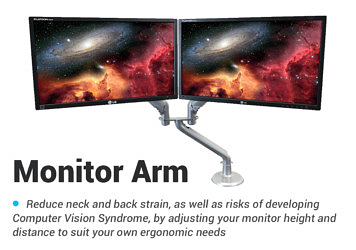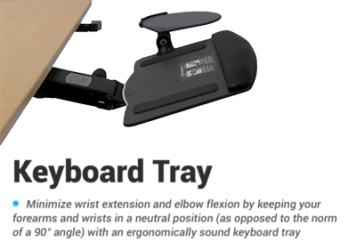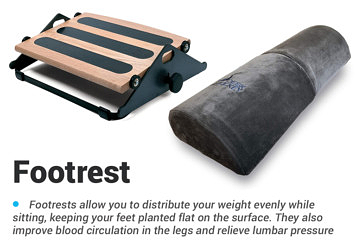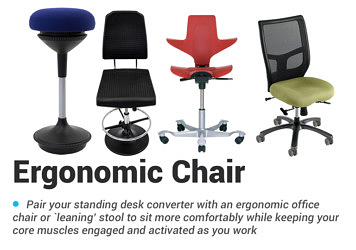How to Compare Warranties on Standing Desks
- Must Read
Like most reviews sites, our editorial staff and laboratory testing expenses are partially offset by earning small commissions (at no cost to you) when you purchase something through those links. Learn More

Let’s start out with some empirical truths
The likelihood of tapping the warranty policy of your standing desk is inversely proportional to how much you spend on it. To cut costs in order to be more price competitive, manufacturers use cheaper components, cheaper and less skilled labor, and often, especially in the case of Asian manufacturers, they skimp on quality assurance testing — or skip it altogether.
Commodity producers will test every tenth unit coming off the line, and only test every unit in a batch if the overall failure rate of the one-tenth sample lot exceeds eight percent. This may be rational for their business model as a high-volume manufacturer, though for the consumer it can turn into a hassle to deal with a failed component on something like a standing desk. We’re not talking 3-ounce, $20 earbuds here.
Labor is the biggest input cost for a manufacturer of a standing desk, and there are only three ways to fundamentally remove labor from the equation:
- Shift as much of the assembly process to the consumer as possible; such is the case with a bottom-dollar product like the Autonomous SmartDesk 2 that comes with a bag of 48 bolts and screws. Or IKEA standing desks that have an infamously high assembly failure rate.
- Put more money into engineering a better design up front, investing in more tooling, robotic lines and test jigs, to reduce the number of components human hands need to touch.
- Use more expensive components that are less likely to fail QA steps and thereby reduce re-work hours and waste.
Commodity producers tend to focus on No. 1, while quality producers tend to focus on No. 2 and No. 3 in order to be as competitive as possible.
The difference between the end-sellers and their OEM suppliers
It’s important to understand that 99 percent of the time, the companies that make the all-important base frames for standing desks are not the ones selling them to you. There is another company in between that sources the base, sources tops, creates the end product (component selection, testing, documentation, packaging, warehousing and fulfillment, submitting the complete desk “system” to ANSI/BIFMA for certification, etc.), and does all the branding, pricing, advertising, sales and customer service. Even Steelcase sources their electric desk bases from a vendor as they do not manufacture.

The base supplier is an “OEM” (original equipment manufacturer) to the company that markets the full desk system. Their warranty is to their customer (the end-seller), not to the end consumer (you). So the seller can decide to offer a warranty that’s even better than the one their factory gives them if they feel it’s important to be competitive.
It’s like when Toyota buys an engine from Cummins to put in a Tundra pickup. The consumer’s warranty relationship is with Toyota, not the OEM manufacturer of the engine in their car. Toyota may go back to Cummins on some warranty issues, but choose to absorb others. That’s all negotiated together as part of Cummins’ OEM pricing contract with Toyota.
Difference in attitude towards Quality versus short-term Profit
One of the biggest differences between bases manufactured in America versus China is that factories in China do not ever want to retrieve a failed part from a customer. It’s just way too expensive and cumbersome to retrieve across an ocean, and so they will simply credit their OEM customer’s next order for one unit instead. American factories are much more likely to want to retrieve the failed part from the customer, through their OEM customer, in order to lab analyze it.

American base manufacturers aim for zero failures on the line versus trying to keep it under eight percent. And they invest significantly in squeezing that number as close to zero as they can get it. That’s why you pay so much more for a standing desk from Big Furniture (e.g. Steelcase, Herman Miller, Knoll) that use American OEM suppliers like Linak (Danish owned), OMT Veyhl (German owned) or ROL Ergo (Swedish owned) for their high-performance, state-of-the-art linear actuators that are designed and certified to be “commercial contract grade” durable.
Upwards of 99 percent of all the companies selling standing desks purely through e-commerce, source their bases from Chinese, Taiwanese, Malaysian, Vietnamese or Korean manufacturers. Of the handful of those that buy bases from the American base OEMs, iMovR is the only one of significance. Although we’ve seen “Big Furniture” attempt to pivot to selling work-from-home solutions direct-to-consumer during the pandemic, they have utterly failed to gain any significant market share so far, and soon return their focus to enterprise customers once workers start returning to the office.
At the end of the day, the desks least likely to break on you are the ones that use the best components, are laser cut and robotically welded, and are largely pre-assembled and individually tested before shipping. The more of the assembly process that is put on you, the end customer, the more likely you will run into a warranty issue because of a part failure or assembly failure.
Yes, this means there is a direct relationship with the price you pay. That’s why Lexus and Mercedes customers see a lot less of their service departments than low-end car buyers do.
Check out the warranty limitations BEFORE you buy
The legalese on most Limited Warranties (they are all, by definition, “limited”) can be written in such a way as to only be decipherable by a qualified attorney or they can be written in plain English. We’ve seen it all in our laboratory testing of literally dozens of standing desks over the years.
Sometimes the warranties are so well hidden you have to actually buy the product to find it in small print inside the assembly manual. This is especially true of commodity-quality, Chinese-made standup desks sold on Amazon. Even though Amazon requires sellers to post their warranties, the only publication requirement of sellers is the term of the warranty, not specific limitations.

In many cases when we’ve checked Amazon information as part of our review of a standing desk, it turns out that the link to the warranty goes to an empty page or one that doesn’t relate to the specific product being advertised.
Increasingly, when we click on the link that’s supposed to take us to the detailed warranty information all that Amazon displays this message: “Please contact the seller directly for warranty information for this product. You may also be able to find warranty information on the manufacturer’s website,” with no link for either.
This is one of many reasons why we strongly recommend users do their own research outside of the Amazon platform before purchasing.
Standing desks are large and heavy objects, not t-shirts. So if you cast caution to the wind and buy an inexpensive one on Amazon thinking you’re a Prime member and therefore will have an easy time of hassle-free and cost-free returns, think again. In the vast majority of cases, these stand-up desks are being “seller fulfilled,” not shipped from an Amazon facility, and such sales are subject to the seller’s return policy. These policies usually burden the return shipping cost on the user and may include restocking fees and/or refund reductions for any damage to the unit, including damage incurred in transit back to the vendor, which is always hard to refute. So, caveat emptor.
Consumer Alert: Warranty term is no longer a reliable predictor of product quality
In days of yore, we used to advise our readers that they should look to the warranty terms as a reliable indicator of what the manufacturer thinks of the durability, reliability, ease of assembly and overall quality of their own product. This is, sadly, no longer the case.
We have seen it all in reviewing products in over twenty categories besides standing desks, (e.g. treadmill desks, standing desk converters, monitor arms, keyboard trays). There are always some sellers out there that put a lot of marketing spin on their warranty terms, especially the high volume Chinese manufacturers. Their aim is to make it sound like a super high-quality product but in truth, the warranty coverage is significantly diminished by all the things they carve out in fine print.

Indeed, we’ve recently seen a spate of online sellers of Chinese-made standing desks (e.g. UpLift and Fully) bump up their warranty coverage periods to make their products seem more reliable than they really are. Some of these companies used to in fact offer extended warranty policies (kind of scammy), which few consumers actually went for. At some point having a lifetime or 15-year warranty on a desk isn’t going to be any more swaying for the consumer than a shorter one if they don’t imagine themselves still working at that company, or even at a desk, in 15 years. But, the term of the warranty is meaningless if the exclusions to that warranty also make it easy for the manufacturer to wiggle off the hook (read more below).
There is fortunately still one reliable rule of thumb when it comes to warranties, and that is that standing desks made in the USA tend to be written in plain English, have fewer exclusions and far, far better customer support than desks made overseas.
American end-sellers tend to be more interested in building a long-term relationship with their customers, and are much more likely to bend over backward resolving customers’ issues. It’s also comforting to know you can reach a human being by phone during American business hours when you need assistance — and be able to communicate effectively.
Don’t just believe what a seller says about their own products without doing some due diligence
It is always wise to check independent reviews (assume that most vendors curate reviews left by customers on their own websites to suppress bad ones from appearing) and do more research in advance of their purchase, and not just believe the often hyperbolic marketing hype on a sellers’ Amazon listings or website copy.

Most consumers are aware by now that many sellers on Amazon, in particular Chinese companies, plant fake reviews — which display as “verified buyer” reviews — by the hundreds and thousands. Be sure to watch the 60 Minutes report on fraudulent review factories in China in case you missed it.
Remember, there is no law against advertising a standing desk as being “the No. 1 [selling/rated/most-reliable/whatever],” which is why we launched this website way back in 2013 as a focused lab-tested reviews site for everything in the office-fitness category. Be a savvy consumer and don’t skip on essentials like checking out the warranty policy, and don’t be afraid to open a live chat and ask the company where their product is manufactured if that information isn’t published on the website.
Examining the worst-case scenarios
Standing desks universally have two components: the base and the desktop. We invite you to nerd out on the most common quality issues with both, which we cover comprehensively in our primer on The Differences Between American-Made and Asian-Made Standing Desks (primarily dealing with the bases) and our Ultimate Guide to Desk Top Materials Used In Standing Desks.

Of course, by far the most common quality problems are discovered when your new standing desk first arrives and gets unboxed. Either a part is missing, parts don’t seem to go together as the instructions say they should, or parts don’t work correctly after assembly. So this is where product quality is truly important because a cheaper import product will, as a rule of thumb, be much more likely to result in some challenges during the first setup as compared to a premium-quality American-made product.
You will want to get a good sense of how easy it will be to reach the company in the event you have a problem, and by what means. Will you be forced to go through an Amazon email relay or will you be able to just make a phone call, for example? Does the company provide real-time live chat support with a product expert, perhaps even on evenings and weekends when you have the time to deal with it?
But, the very worst case scenario we’ve seen from time to time is a user whose desk stopped working just as they were transitioning between sitting and standing. A desk stuck at 35” is incredibly frustrating because it becomes unusable at this middling height.
Unfortunately, the linear actuators (lifting columns) in a standing desk are actually most likely to fail while moving. This is why we always advise consumers never to ignore a squeaky or shaky standing desk, as this can be an indicator of impending failure. While it could just be that the desk isn’t perfectly level with the floor, or the bolts and screws have gotten loose over time and need a little retightening, you want to perform periodic maintenance on your standing desk just like any other expensive electromechanical appliance to ensure its reliable operation for years to come.

Let’s say the worst does happen. One lifting column or the entire desk actually fails. When you contact customer service they will have you go through a controller reset first, assuming your handset actually lights up. If re-initializing the legs’ position index doesn’t work they’ll start going through a diagnostic procedure to see if they can isolate the problem to a loose cable, a burned-out power supply, a failed controller circuit or handset, or one of the legs. This is easiest done over the phone or Facetime, or at the very least live chat as there are many steps to a typical diagnostic.
The next question is how difficult will it be to disassemble the component from the desk and potentially ship it back to the vendor. Often times vendors will not simply ship a replacement without receiving back the presumed bad component, to make sure it’s really the problem.
So-called Quick Install standing desks tend to be a lot easier to deal with since popping out a failed leg takes seconds. (Certain models also tend to very rarely fail since they’re pre-assembled and individually tested at the factory before shipping.)
Warranty carve-outs sellers insert to allow them to wiggle off the hook
Virtually all warranties will have standard legal verbiage that says if your office was wiped out by a tornado, i.e. the “Act of God” clause, they are not responsible for the damage to your desk. There are also usually terms like “misuse” or “abuse” by the customer that will void the warranty, which makes sense. If you take a sledgehammer to your computer because it lost the one and only copy of your 2,000-page manuscript of the next great American novel, the manufacturer should not be held liable for the crack it left in your desktop.
“Normal wear and tear” isn’t going to be covered by any warranty, either. This makes sense as well. The question is, what is “normal”? Especially during the pandemic when many consumers and commercial cleaning crews have been routinely using harsh disinfectants to clean desks with, desktops that have seamed edges are coming apart because the exposed glues are drying out from all the alcohol and other chemicals in these cleaning solutions. Should that be on the manufacturer or on the owner of the product?
In principle, if the customer used cleaning methods different from those prescribed by the manufacturer, it may wind up on them. The problem is that many manufacturers don’t even have a “how to clean” statement on their websites or in their manuals, so this is one way they’ll wiggle off the hook, by saying “you must have used the wrong cleaner to make this desktop delaminate like that.” (See our guide to safely cleaning every type of desktop.)
So when it comes to desktop integrity, if you can’t even find thoroughly detailed cleaning instructions for the desktop and the base posted on the company’s website or downloadable manual — stay within those guidelines — be prepared to discover that the 15-year warranty on your desktop will likely never be honored past the 30-day return window.
Desktop warranty coverage is particularly important when it’s the most expensive component of your desk, as is the case with solid wood standing desks. Yes, part of owning a solid-wood desk is knowing that it has natural movement as humidity and temperature varies over time. Natural wood tops are going to gain “character” from dings and scratches over time, much more so than harder HPL or 3D laminates.
But, if a desktop you paid two grand for actually develops a crack one day, will the manufacturer cover that as a “material or manufacturing defect” or not? This depends entirely on the company. For example, UpLift definitely carves it out of their warranty, stating, “Solid Wood, Butcher Block, and Bamboo desktop and material/finish variations and imperfections. This may include, but is not limited to, hairline cracking due to wood contraction from changes in temperature and humidity. Desktop imperfections are considered normal wear and tear if the structural integrity of the desktop is intact.”
So unless the crack is so bad that your desk literally can’t go up and down anymore UpLift may bounce your claim. Or, they may claim that the triple LCD monitor arm (that perhaps they sold you) put too much weight on the back edge of the desk and therefore it was “misuse” that led to the failure of the desktop.

In contrast, other premium brands are more forthright about disclosing proper desktop care before the sale as well as on instructions that are literally taped to the desk when first opened. These companies tend to be far more likely to honor their desktop warranties if the customer acknowledges that they didn’t stray from the prescribed care standards. An example of this is iMovR’s care guides for their ultra-premium solid wood desktops, and the care instructions for their 3D-laminated desktops even list all of the EPA’s recommended chemicals for COVID disinfection (none will void their robust warranty).
When it comes to solid-wood desks, the benefits of factory pre-assembly units are even greater. While UpLift, Fully and others sell solid-wood standing desks that the user puts together themselves, they have to have these warranty carve-outs in case the user over-torques the screws into the wood, thus exacerbating the potential for cracks to form as the wood expands and contracts. Pre-assembled desks are built by expert furniture craftsmen that know the proper shop techniques needed to allow for that natural movement without putting undue strain on the base frame or the desktop.
The same advice goes for the lifting columns, if you ever wiped away those nasty oil streaks running down the legs of your standup desk without immediately re-lubricating them, using only the prescribed brand of grease (e.g. white lithium). This, again, goes back to the quality of the product. The fact is that cheap desktops do warp, crack and delaminate over time. And cheap bases get unsightly oil streaks on the legs (a good reason to avoid white or silver when buying a cheaper desk).
Does hiring someone else to assemble your desk void the warranty?
This one is a doozy. Sellers like Fully and UpLift have a Jupiter-sized hole to wiggle out of warranty coverage through in that if you used a third party like TaskRabbit or Thumbtack, or even your handyman to assemble the desk, they can bounce your claim.
Worse, according to one major seller’s warranty exclusions “Any damages or malfunctions in the product caused by repairs, or attempted repairs, performed by anyone not affiliated with or authorized by Fully.”
Does disassembling your desk to move it void the warranty?
This is another doozy. With few exceptions, those being the quick-install models, standing desks are not designed to be disassembled. Most manufacturers don’t put instructions in their manuals or create videos for how to properly disassemble their desks without permanently damaging them.

At the very least, cheaper desktops that use low-grade fiberboard or particleboard cores will usually need to be shifted over an inch and have new holes pre-drilled, as the original ones can disintegrate simply by removing the screws that were holding the top on the base. Premium desktops that use insert nuts and bolts instead of wood screws are definitely a better choice when you have the option.
Reboxing is the next challenge. Unless you kept the original packaging of your desk it will be very challenging to safely pack the parts back up for shipping. And furniture movers will often want to disassemble the desk because the legs take up so much empty space, or jam it into the truck with nothing but a blanket to protect its delicate electromechanical components. We’ve seen standing desks costing thousands of dollars utterly destroyed by “blanket wrap” moving companies, not just freight carriers.
The only standing desk we’ve ever seen that was literally designed to be disassembled and re-boxed multiple times (there’s even a video on how to do it) is the ZipDesk. It was uniquely born of the pandemic era when many customers wanted to know that they could easily move the desk back to their office or their kid’s college dorm room down the road, for example.
When should you have to register your warranty?
In this day and age when most purchases of things like standing desks are online, proof of purchase is pretty easy to search for in your inbox archives. But, if you purchased your product through an online marketplace like Amazon or Overstock.com, then you should definitely take a minute to register your warranty with the actual manufacturer.
Note that warranty coverage only inures to the original purchaser. If you buy a used standing desk the warranty will not transfer to you.
The benefit of a long return window when buying a standing desk
Most online sellers give you just 30 days to return the product. That’s great for a pair of jeans that you can try on and figure out pretty quickly whether they fit or not, but it often isn’t enough time to get around to putting together your new standing desk and using it long enough to see whether it’s really of decent quality, or not.
A lot of folks have to first get rid of their old desk, which they won’t get moving on until the new desk has arrived. Already the clock is cut short by some sellers who consider the date of shipment as the start of your return window versus the date of receipt. Especially nowadays with COVID-impacted parcel and freight delays often causing it to take a week, two weeks or longer for the desk to reach you from the seller.
The cheaper the desk, the more work you’re likely going to need to put into assembling it, and you may run into a bad or missing part issue, or lack the best power tool for the job, delaying completion of the task.
If you’re like many of our readers, by the time your new height-adjustable workstation is all put together you’re likely going to invest more time in getting your monitor(s) set up on a monitor arm, adding on a keyboard tray, mounting your computer with a CPU holder or tech dock, adding power modules and running cable management. All these things take time, and some of them require the desk to be cleared off and flipped over, like if you wanted to add caster wheels after you already built your desk.

By the time you really get your workstation all set up and fully weight-loaded, and run the motors up and down enough times to really observe how well the legs are working, how good the stability is, and observe whether it starts generating squeaks or oil slicks on the legs, etc., most of your 30-day return window may have transpired. You may not even have enough time to disassemble it, rebox it (you kept those original boxes, right?) and take it wherever to get shipped back to the seller.
For all these reasons, we always recommend asking in advance how strict that 30-day window is if you find out it’s really not the desk for you. You should also think through how much return shipping will cost you. Not sure which desktop color to choose? Order samples to examine before buying the desk. Not sure what size desktop to order? Measure the space it will go into before committing to the purchase. A standing desk is just a much harder item to ship back than the wrong color blouse that turned out not to look so good on you, or not fit well.
Not surprisingly, the most bottom-dollar e-commerce standing desk seller of all, Autonomous (a.k.a. “Smart Office”), has the harshest policy when it comes to warranty claims, essentially carving back the warranty claim period for shipping damage to SEVEN DAYS! They state: “All shipments should be inspected immediately upon arrival. Please make note of any damage to boxes when signing for shipment. Report any losses or damages promptly to Smart Office… Notification must be made within one week of delivery. Save all packaging until the 30-day trial period has ended in the case of needing a return. All returns MUST be authorized by Smart Office, which will advise you as to return authorization and arrange for pickup of any damaged merchandise. If your order does not arrive within the delivery timeframe please let us know immediately, we cannot be responsible for claims filed more than thirty days after the delivery period.“ This from the company that famously had up to a 5-month delay in shipping their product after collecting payment from their customers, causing a major reputational nightmare for them on Reddit. It bears repeating… caveat emptor. If you’re thinking of buying this product be sure to read the full list of warranty exclusions first.
The best sellers these days offer 100-day return windows, following in the style of Purple and other memory foam mattress companies that recognize the fact that it may take a while before the customer really gets a feel for whether or not they like the product.
Beware of “the shift game”
This is mostly an issue for corporate buyers, but if you buy a standing desk for, say, a 24×7 call center, some warranties will actually reduce the warranty term by up to 76 percent, saying their warranties are based on 40 hours per week of use. This is common with Big Furniture vendors like Herman Miller and even some e-commerce sellers like UpLift that state in their long list of warranty exclusions that, “Above single-shift use, eight hours per day, 40 hours/week. Warranty periods are reduced proportionally for above single-shift use.”
The question nowadays with many people working from home is whether a home office is considered a one-shift or two-shift environment, since you’re as likely to be checking emails at 6am as you are to play video games at 10pm. We haven’t heard from any readers yet about whether they’ve been challenged on their warranty coverage over this issue, but a few years down the road we wouldn’t be surprised to start hearing about it. For enterprise customers this should always be determined in advance, especially for call centers.






0 Comments
Leave a response >